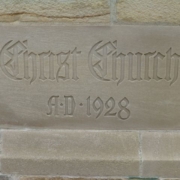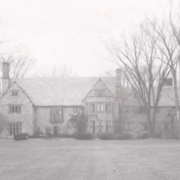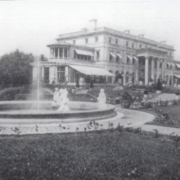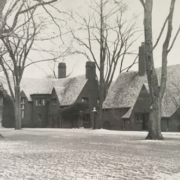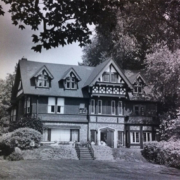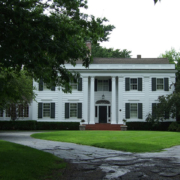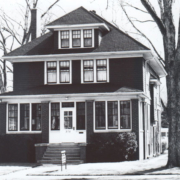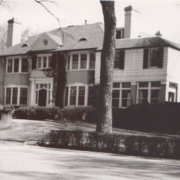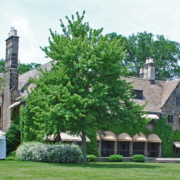Historical Architecture of Grosse Pointe – The Cathedral That Never Was – Christ Church Chapel – Part 2.
Continuing the story of Christ Church Chapel – part 1 from last week, we will now take a look at the unusual method used to construct the building along with exploring some of the wonderful elements that can be found inside the Church.
As with most Gothic structures the exterior of the chapel is constructed from stone. Just like many churches that were built in the Middle Ages there are no nails, or plaster, just wooden pegs, stone and mortar. The light sandstone present on Christ Church was quarried in Clearville, Pennsylvania, chosen for its iridescence in sunlight. There are many wonderful intricate details carved into the stone, and the detailing over the windows is superb.
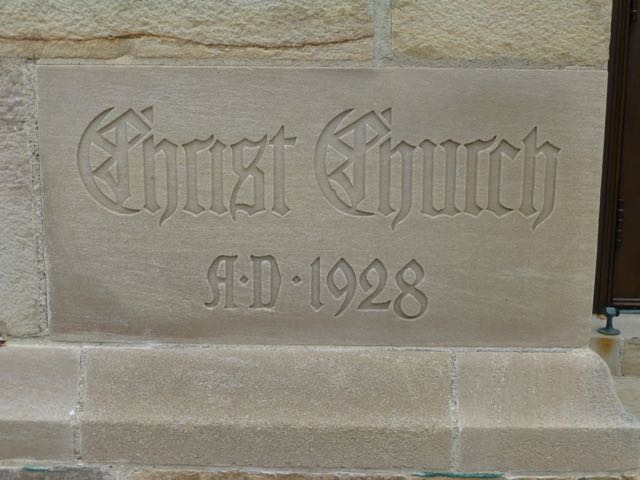
The roof is covered with slate, with copper ridges and a copper spire. Grey limestone from Indiana was chosen for the inside, because it was restful. The floor is sandstone. Fine woodcarvings adorn the interior, including the choir stalls, pulpit and the lectern. The reredos – carved in oak – were crafted by Mowbray’s, London, England, while the roof beam’s and other pieces were the work of J. Jungwirth Co. and Pom-McFate Co. of Detroit. The dark brown wood interior provides the perfect material in which to heighten the effect of light filtering through the superb stained glass windows.
The stained glass windows are Christ Church’s most outstanding feature. The majority of the stained glass was not installed at the time of the chapels’ completion, the wonderful Salvator Mundi window (designed by Clement Heaton of London), which now adorns the altar, was not installed until 1935. Ten more windows were then added in 1942 – designed by the Willet Stained Glass Company of Philadelphia, the windows depict significant events in the life of Christ. The window over the balcony depicts the parable of the Good Samaritan. It is believed the window is created in picture book fashion, as it would have been told in the Middle Ages for people who could not read. It is executed in a combination of Gothic colors – greens, blues, reds and yellows – however it is unknown who designed the window and when it was installed.

Good Samaritan Window – Courtesy of ‘Discovering Stained Glass in Detroit’ by Wayne State University Press. Photograph by Dirk Bakker.
According to Nola Tutag, Christ Church member and author of Discovering Stained Glass in Detroit the Stained Glass windows in Christ Church are a fabulous example of antique hand blown glass, which allows the color to permeate through, as opposed to modern stained glass which is an enameled, surface type. The color of the glass throughout is breathtaking and changes constantly depending on the weather and the light at different times of the day.
The church building has also seen many improvements over the years. In 1935, the tower carillon of 23 bells and an automatic playing machine were installed. The original organ (installed by Casavant Freres of Quebec) was replaced in 1958, and during 1959 the church was fully air-conditioned.
In 1966 the pretty Virginia Brush Ford Memorial Rose Garden was finalized, given by members of Mrs. Ford’s family and her many friends. Christ Church was the Ford Family Church. In 1967, the construction of the Columbarium was completed, encompassing the rose garden. It has since been enlarged four times and now contains 648 niches.

Eighty-five years on Christ Church remains an integral part of the community. Many churches built at the time were constructed in a modern architectural style, however the founders of Christ Church wanted something different for the congregation and it certainly stands out from the crowd.*
Christ Church Chapel was listed as a designated Michigan Historical site in 1992 and listed on the National Register of Historic Places in 1993.
Written by Katie Doelle
© 2015 Katie Doelle
* The congregation was given the status of a full parish in 1947.
** Research from Grosse Pointe Heritage Magazine, courtesy of Grosse Pointe Public Library Local History Archives.

